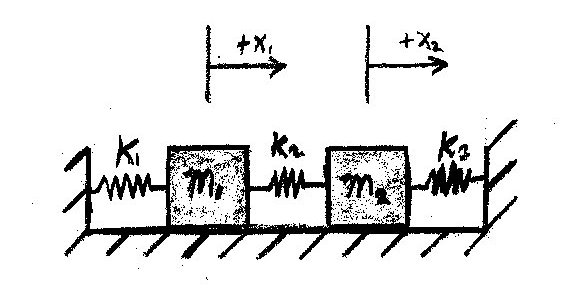Coupled Oscillator: Hellie: Difference between revisions
Jump to navigation
Jump to search
| Line 59: | Line 59: | ||
</math> | </math> | ||
With the numbers... | |||
<math> | |||
\begin{bmatrix} | |||
\dot{x_1} \\ | |||
\ddot{x_1} \\ | |||
\dot{x_2} \\ | |||
\ddot{x_2} | |||
\end{bmatrix}\, | |||
</math> | |||
= | |||
<math> | |||
\begin{bmatrix} | |||
0&1&0&0 \\ | |||
\frac{(-50 N/m)}{15 kg}&0&\frac{-100 N/m}{15 kg}&0 \\ | |||
0&0&0&1 \\ | |||
\frac{100 N/m}{15 kg}&0&\frac{(250 N/m)}{15 kg}&0 | |||
\end{bmatrix} | |||
\begin{bmatrix} | |||
x_1 \\ | |||
\dot{x}_1 \\ | |||
x_2 \\ | |||
\dot{x}_2 | |||
\end{bmatrix} | |||
+ | |||
\begin{bmatrix} | |||
0&0&0&0 \\ | |||
0&0&0&0 \\ | |||
0&0&0&0 \\ | |||
0&0&0&0 | |||
\end{bmatrix} | |||
\begin{bmatrix} | |||
0\\ | |||
0\\ | |||
0\\ | |||
0 | |||
\end{bmatrix} | |||
</math> | |||
Eigenmodes | Eigenmodes | ||
Revision as of 14:41, 25 November 2009
Problem Statement
Write up on the Wiki a solution of a coupled oscillator problem like the coupled pendulum. Use State Space methods. Describe the eigenmodes of the system.

Initial Conditions:
State Equations
=
With the numbers...
=
Eigenmodes
- There are three eigenmodes for the system
- 1) m1 and m2 oscillating together
- 2) m1 and m2 oscillating at exactly a half period difference
- 3) m1 and m2 oscillating at different times
Solve Using the Matrix Exponential
Written by: Andrew Hellie